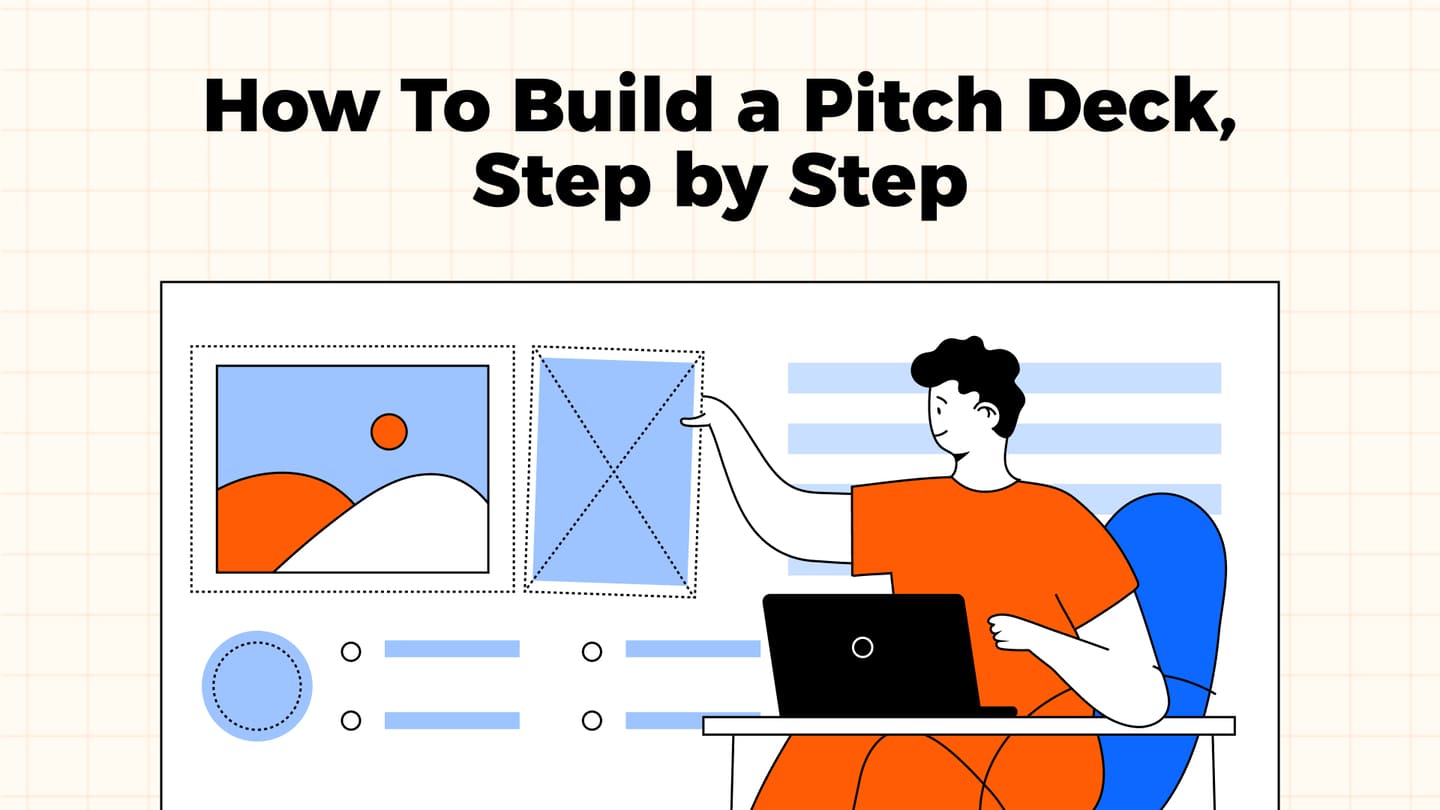
How To Create a Perfect Pitch Deck — Step-by-Step Guide

A pitch deck is a short presentation of a business or a business idea created to attract potential investors or clients. It's called a "pitch deck" since it's usually a series of slides or sheets a business owner pitches to investors or customers. It is the introduction of a business, the first (and sometimes the last) impression you, as a startup owner, can make. Creating the perfect pitch deck is like the first step to your business, and its goal is to get you to the next one where the funding of your startup can be discussed.
Let’s say you have an app idea. You want to build a Tinder for pets. You make a business plan and you calculate how much it costs. You come to the realization that to launch your product, you need funding. So, you start creating a pitch deck for investors. You wonder how to make a good pitch presentation so that investors fall in love with your app idea just like you do.
Let’s be honest, building a pitch deck is a must for every business that seeks investment. We’ll walk you through the pitch deck format, structure, and design.You will also get some of our best tips and learn about common mistakes to avoid. And, of course, we prepared a selection of software to help you with pitch deck creation as well.
Understanding the Purpose of a Pitch Deck

Statistically, 99% of pitch decks fail to impress investors and fail to get funding. Scary, right? Well, don’t fret - it makes perfect sense. If a startup cannot put a coherent and attractive presentation, how can it build a business one is willing to put money into?
The truth is, investors are bombarded with pitch decks all the time, with over a thousand of them created daily in California alone. The latest stats show you have under three minutes for your pitch deck to persuade the investors to talk to you about your business. So, wonder how to create a pitch deck that gets into the lucky 1%? What does it have that the rest lack? First and foremost - you need a clear purpose for each of the parties, namely, the investors, the partners, and the internal team. Let’s take a closer look.
For investors: secure funding
The best pitch deck examples prove that a successful presentation clearly and shortly communicates the vision and value of the upcoming business. It makes a strong case for why investors should fund the business and how they can benefit from it. It demonstrates the value and credibility of the pitched business quickly and effectively. In short, a pitch deck tells the investors if the business is worth learning about and considering investing in it.
For partners: showcase collaborations
Professional presentation deck design services use a pitch deck as a great tool to secure strategic alliances. A strong pitch deck proves the credibility of the business for potential partners. Partners look for different things in a pitch deck than investors. As a rule, they focus on the pitch deck value proposition slide to find out what customer problem you are going to solve, how you plan to do it, and what the benefits of choosing your services are. You can use a perfect pitch deck as your major partner-making resource when you put it together.
For clients: present unique value
The unparalleled value of the presented solution is what makes a good pitch deck in the eyes of a potential consumer. Your clients need to see and comprehend the ways that your solution is aimed at making their lives better. You can start by stressing your main strengths, advantages, and proven track record, which supports your promise in full.
When creating a pitch deck for clients, it helps to treat it like an official introduction of your business to the consumer base. If you inspire enough interest and trust, you will become a step closer to a successful partnership and long-term relationship.
For internal teams: align company vision
A pitch deck vision slide is a perfect place to set your company vision clear and exact for the whole team. Everything in a pitch deck represents your company, so you can refer your new employees to it when introducing them to your startup. When your business purpose, strategy, and goals are unified and written in the pitch deck, you can easily make sure everyone on your team is on the same page about why, how, and what your business is doing.
10 Essential Components of a Pitch Deck

How to create a business pitch deck that sells? When it comes to the pitch deck structure, it's better to keep things in places where the investors expect to find them. The structure of a successful pitch deck is clear and coherent. As we've mentioned above, investors flip through numerous pitch decks on a daily basis, so it's your job to capture their attention with what and how you put in your presentation.
Now, the content and design of your deck are a good place to exercise your creativity. Imagine you are an investor looking for a fresh promising project. Would you like to see pretty images and diagrams or solid facts and charts? Guess you got the answer right.
1. Introduction: Introduce your company and your mission
The first slides of your presentation are the most important ones. They make the first impression and decide the future of your project. You introduce your project with a ʼpitch deck cover slide that informs the audience about the value of your project and your proposition. For instance, the original AirBnB pitch deck cover slide said “AirBed&Breakfast. Book rooms with locals, rather than hotels”.
What to include:
- A really short description of your business (less than 140 characters) in a way anybody can understand.
- Visuals that grasp the attention and support your story.
2. Team: Who's behind the project?
The team slide is one of the key components of a pitch deck. Explain why you are the people that can bring this project to life. State their expertise and relevant career success that is good for the new business.
What to include:
- Even if you don’t have the team ready yet, describe the team members you need and why you need them for the business.
- Give yourself some credibility by telling how you fit the role of a business owner.
3. Problem: What issue does your business address?
This slide is a place to explain what problem you are going to solve. Explain who has the problem and how you are going to solve it. Expert industry analysis services suggest to mention present solutions on the market for this problem. Don't focus on the competition too much. Instead, speak on the scope of the opportunity.
What to include:
- Present your problem in the form of a real-life story.
- Explain why now is the best time to address the problem and offer your solution to it.
4. Solution: How does your product/service solve that problem?
The next vital startup pitch deck outline element is the solution slide. After you’ve told what the problem is, time to tell what can be done about it. Explain how the customers can solve their problems with the solution you offer. Do it concisely and clearly, showing its scalability potential.
What to include:
- Some modesty. Avoid naming your solution the one and only, unique and out-of-this-worldly altogether. It could be true at the moment, but you will have competition inevitably.
- Make it clear why there is a need for this solution right now.
5. Market Size: Potential growth and total addressable market
Next, a business pitch for investors should include a market size slide. It’s a summary of your market research. Investors want to see how the potential market for the product looks and what its scale is.
What to include:
- Specify your market. This way, investors see you understand who your target customers are and you know how you can tailor your product to their needs.
- Inn graphs, show market growth and potential that add validity to your offering.
6. Business Model: How you plan to make money
Now you’ve explained what the problem is, who has this problem, and how your solution solves it. It's time to move on and allow the sales deck design to describe how you are going to sell your solution to the customers. State clearly who pays the money for what you offer and how you expect to keep the cash flow up.
What to include:
If you already have a pricing strategy, explain how it fits in the existing market.
- Display your achievements to the investors, whether it’s an expanding customer base or a growing social media following.
7. Marketing & Sales Strategy: Acquiring and retaining customers
After explaining how your offering is necessary and viable, show that you know how to attract those customers and sell to them. Summarize your sales and marketing strategy in this slide. Show that you understand what channels to use to reach the customers.
What to include:
- Use visuals like graphs, diagrams, flow charts, or others to explain your sales and marketing strategy clearly and concisely.
- If your sales and marketing strategy are different from the competition, say it.
8. Competitive Landscape: Your main competitors and your edge
A summary of your competition comes next on the slide deck outline. Even if you enter a market no one has ever been to before, your target customers still solve their problems in one way or another. So, explain how you are different and what makes you better than the competition.
What to include:
- Explain how your solution compares to others on the market.
- Use visual tools to make your competitive advantage clear.
9. Financial Projections: Expected revenue, costs, and profit
The pitch deck revenue model slide is a place to show your finance flow predictions in a visual and concise form. Typically, investors expect to see what you plan for at least three years ahead of you, even though it’s clear that nothing is set in stone at this stage. If your business hasn’t been earning any money yet, predict based on the market research.
What to include in a success-oriented financial slide
- Include realistic figures rather than stating the most optimistic numbers. Investors have an excellent understanding of the market, so don’t try to cheat.
- Make predictions for the duration of three to five years in your forecast.
10. Ask: Clearly define what you're seeking (e.g., investment, partnership)
Use of funds pitch deck slide is a place where you finally do it - ask investors for their money. Explain how much money you need and how you are going to spend it. Tell them how the required money will help you to reach your business goals and what you plan to do when you reach them.
What to include:
- A clear plan for spending the investor’s money
- If your business already received some investments, explain why they decided to trust in your business.
Now, after we talked about everything in a pitch deck outline, let’s move on to discuss how to design a pitch deck that wows the investors.
Tips for a Successful Pitch Deck Design
.jpeg)
What does an industry professional who sees tons of pitch decks daily look for in pitch deck design? Karin Klein, a founding partner at Bloomberg Beta, Bloomberg LP's venture arm, recalls a successful deck of a tech-enabled real-estate startup, saying “the deck included visuals so the reader could almost experience being in the locations”. Most investors say the same thing - it’s always better to show your product in visuals than describe it in words.
So, how to make a perfect pitch deck design? Check out the following requirements:
- Keep It Concise: Less is more. Aim for 10-20 slides. Investors look through tons of pitch decks quickly, and they aren’t looking for a novel there. You could even go as extreme as cutting it to five slides. Time your presentation to see if an investor could get through it in under three minutes.
For instance, Airbnb had a minimalist 14-slide pitch deck that worked for them.
Airbnb Pitch Deck
- Visual Consistency: Uniform fonts, colors, and graphics.
A carefully researched and calculated business should not have a messy presentation with repelling graphics and fonts. Make sure all your pitch deck elements make a composition, not a mess.
Take a look at this short and neat pick deck:
Sensorfact Pitch Deck
- Use High-Quality Graphics: Infographics, charts, and relevant images.
A great pitch deck shows the story in a clear and comprehensive visual way rather than describing it with long words. Run your best pitch deck design ideas through with a professional designer if you can. They can help you improve the visual part a lot.
For example, take a look at the Dandelion Energy Pitch Deck.
Dandelion Energy Pitch Deck
- Engaging Storytelling: Write a narrative that takes the viewer on a journey. Developing a pitch deck that takes you to the world of the target customers is a great tactic. An engaging story with proven facts adds credibility to your business and also shows that you know the market well. You can go with the problem-solution narrative, sales pitch - customer success story impactful storytelling, success story, etc.
Here is a good example of a pitch deck with an engaging problem-solution narrative:
Klima Pitch Deck
- Data Visualization: Make numbers and stats easily understandable.
Charts, graphs, and other visual components are pitch deck essentials that help you show the potential of your business to investors. The key here is to choose visual tools that fit your business, balance the aesthetic and quality of the content, and always prioritize readability.
Here’s an example of an IoT product pitch deck that is appealing visually and also easy to read. Note how everything that can be is turned from words into visuals.
Include Pitch Deck
Documents to Include With Your Pitch

Now that we’ve talked about the slides to include in a pitch deck and how to make them appealing to the eyes of the investor, let’s move on. What other documents do investors want to see along with your pitch deck? Here they are:
- Cover Letter
It is a short story behind your business that intends to persuade the investor to view your business idea. It’s best if your cover letter is a brief and engaging summary that explains the problem your customers have and how your product successfully solves it. You don’t need to cover all the details in the letter. Just tell enough to spark the investor’s interest. - Elevator Pitch Statement
In short, an elevator pitch statement is a one-page pitch of your business. It should summarize your business as short as possible, making it sound exciting to join. It should be shorter than an elevator ride, so, 30 seconds or less. Focus on the problem/solution presentation, add the most important facts, and avoid complex and fancy terms. - Business Plan
A viable and well-calculated business plan is one of the most important elements of your presentation for investors. Include a business plan that outlines the strategy for your business. Provide information on your strategy, goal, financial forecast, as well as marketing strategy. - Financial Report
For your pitch deck, you need to create a financial forecast that proves the vitality of your business. The recommended time to make the forecast is between three and five years. Estimate cash flow, profit, and loss, and try to estimate your balance sheet too. Keep your financial forecast optimistic but realistic. - Market research
Add your market research to your pitch to investors as well. When an investor gets interested in your pitch, they are likely to want to study your detailed market research to check that there is truly a need for a product you pitch in the market you intend to sell to.
Common Mistakes to Avoid

How to make a pitch deck that makes investors fall in love with your project idea rather than toss it on a huge pile of decks that never make it? Try to avoid common mistakes most startups make when putting the elements of a pitch deck together.
- Overloading slides with text.
Naturally, you want to share as many project details with the investor as possible. You want to give them a complete picture of your project and its impact. However, just like in real life, oversharing is bad for you and the recipient. How to avoid it? There’s a simple tip. Visualize content where possible and stick to the most important facts only. Take a look at this slide from the Include pitch deck and how they told so much with a few words: - Failing to address potential concerns upfront.
What is the purpose of a pitch deck? To get investors interested in a project by persuading them it’s viable and worthy of their attention. Now, not addressing any concerns and claiming your project makes it a hundred percent is dangerous. It shows investors you have very little market judgment. How to avoid this mistake? Present an exit strategy with potential exit scenarios and address concerns investors are most likely to have. For instance, you can add an exit strategy slide to your presentation or draft it as a separate document. - Using jargon or complex language.
How to make a pitch deck for investors that stands out and sparks interest from slide one? Many startup owners fixate on this question and try to make their presentation impressive at any cost, throwing in more complex terms, professional jargon, and fancy design elements. It’s a tricky road and we don’t recommend you to take it. The most brilliant idea can be described in simple words, so your grandma can understand it and tell it to her friends. Clarity and simplicity are always in style. - Lacking a clear call to action.
And last, but not least - many pitch deck creators don’t have a clear message in the end. Tell your investors clearly and precisely what you want and how you want it. For instance, if you pitch for funding, a pitch deck funding slide should inform your potential investors what kind of funding you seek, how you plan to use it, and what goals this funding helps to achieve.
Tools and Software for Pitch Deck Creation
- PowerPoint:
A good old reliable tool for making presentations can help you craft an effective pitch deck. PowerPoint is one of the most commonly used tools for building pitch decks. It is easy to use and full of design templates and features to create visually appealing presentations.
Rating: 4,7
- Keynote:
Keynote is a presentation software from Apple. It is packed with advanced features and tools to create stunning presentations. You can add animations, graphics, and multimedia to your Keynote presentations.
Rating: 4,7
- Canva:
Canva is a well-known graphic design platform that offers templates and tools for creating designs for personal and business use. It can help you build professional-looking pitch decks. Canva has a user-friendly interface that makes it easy to use for beginners.
Rating: 4,7
- Prezi:
This is a cloud-based presentation software that allows users to create interactive and engaging presentations. Prrezi has a unique zooming feature that makes it stand out from other presentation tools.
Rating: 4,6
- Haiku Deck:
Haiku Deck is a presentation software that focuses on simplicity and visual storytelling. It offers a limited number of templates and features. Yet, they are designed to help users create clean and concise presentations.
Rating: 4,5 - Google Slides:
Google Slides is a free online presentation tool that offers collaboration features, making it easy for teams to work together on pitch decks. It also has a variety of templates and design features to create professional-looking presentations.
Rating: 4,6
There is an alternative to using tools and software for making a pitch deck. You can turn to a professional company like Whitepage to create a custom pitch deck.
Conclusion
A well-crafted pitch deck can help you achieve different business goals, from funding to scaling. It serves many purposes. First, a pitch deck helps the startup secure funding from the investors. It can also showcase collaborations and help establish partnerships as well as help organize the teamwork inside of the company.
Each slide of a pitch deck matters, from cover to the ask for funding. It’s important to keep the structure of the pitch deck consistent visually and concise verbally. All the graphics should be high-quality and easy to read. Data visualization is the cure for slide content overload. And to make your investors interested, you need to tell them an engaging story rather than every aspect of your project. Storytelling is a well-proven tactic that works great for pitch decks as well.
In case you decide to skip go-to-market consulting or any other expert assistance and make use of the pitch deck creation tools and services you can find online, make sure to avoid common mistakes most pitch deck creators make. That is, overloading your slides with text, avoiding addressing any concerns, using complex terms, and lacking a clear call to action.
If you choose to turn to an experienced pitch deck design agency like WhitePage, you can have one less business launch aspect to worry about. Here at Whitepage, we know how to create an effective pitch deck that stands out and we are happy to help you build one for your business!
Talk to a presentation design expert now!
Let's Talk
FAQ

Read more



.avif)

.webp)
.webp)




































